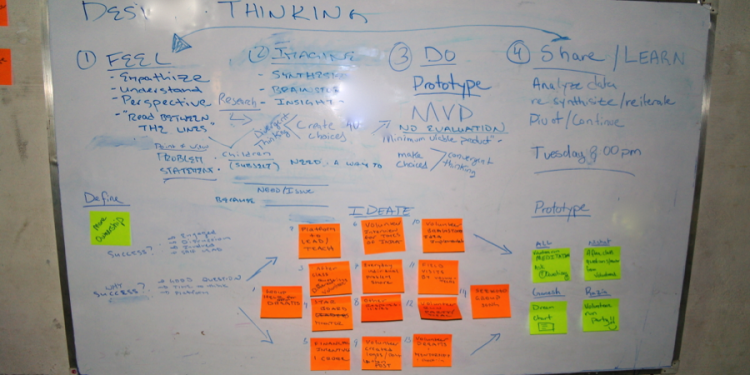Building a Flat Culture Through Design Thinking

What makes an amazing organization? At SEEKHO, we believe in two very important and interconnected philosophies; that everyone is SEEKHO and that more importantly, we are more than a network-we are a family. Whether you provide advice from 10,000 miles away or you live and work with SEEKHO in Bihar, you own this organization. SEEKHO exists as one entity with thousands of voices and ideas working together to make the world a better place. We believe that everyone has the power to be a changemaker and that sometimes all it takes to unleash one’s potential is a little nudge. It is only through this bottom up approach to innovation, where organizational ownership is shared, that SEEKHO will have any lasting effect.
At SEEKHO, we strive to ensure that every member has the platform to surface their own ideas and opinions. While in the context of rural Bihar, encouraging this freedom is not only difficult, but also incredibly important in order to overcome the centuries of the caste system’s social stratification. The process by which SEEKHO goes about breaking down the stifling walls of organizational hierarchy and ingrained social stratification is by combing the empowering solution based framework of Design Thinking, Lean Start-Up, and the Jugaad mindset. The incorporation of these risk-taking frameworks, focused on empathy, has enabled us to foster a tremendous sense of ownership within every member of SEEKHO.
In order to truly communicate how Design Thinking has helped us infuse a sense of ownership amongst our members it would be best to provide some short anecdotes. Both stories share the same beginning; born out of a Design Thinking workshop focused on increasing ownership in SEEKHO. We began with conducting a workshop with 5 SEEKHO members where we used a simplified Design Thinking process called Design for Change.
1) Feel: Our team began testing assumptions, studying the issue and empathizing with SEEKHO members. By the end of this phase we were able to define the problem: Students, teachers, and staff alike experience too much organizational hierarchy. How do we build in a flatter culture and liberate the creative potential of our organization?
2) Imagine: Using the information collected in the empathizing phase, the team identified the needs and motivation of our members. Then, by harnessing the power of collective thought, we came up with as many ideas to solve the problem as we could in 15 minutes (divergent thinking).
3) Do: After narrowing down our ideas, and many times combining awesome aspects of each idea, we decided to prototype two products. Group A would organize a SEEKHO event and Group B would implement a morning leader position.
4) Share: After each project had produced an Minimum Viable Product, we held another workshop to provide quick iterative feedback so everyone can effectively perfect their projects as well as learn from other members.
The picture above depicts our first brainstorming session in which we ideated 12 potential and somewhat outrageous ideas, before narrowing them down.
Group A created the first MVP, a party. While their event went very smoothly and might under other circumstances be deemed successful, because of a high turn out and great atmosphere, the metric with which Group A used to define success was based on a different problem statement. Instead of trying to increase ownership, the event focused on making SEEKHO more inclusive and was analyzed as such. The problem statement was misconstrued and as a result, Group A focused on doing everything for the event rather than facilitating the experience through asking the other teachers their opinions, then letting them decide how to run it.
This is incredibly important to note because it illustrates how easy it is to be misled if one does not stay true to the original problem statement. Having fun and showing up are metrics that the Lean-Start Up calls “vanity metrics” because while they “give the rosiest of pictures” they do not accurately illustrate the issue. The Design Thinking process saved us from straying too far from our problem statement and showed us that what we needed to look at were “actionable metrics” which accurately reflect the issue. During the workshop, we defined the “actionable metric” as how much of the process the teachers owned and how much individual autonomy they felt. Lastly, while their project now looks like a failure, on the contrary, what we learned was invaluable. By producing an early MVP and gathering rapid feedback, Group A saved time and energy, that might have been invested in future projects not inline with team goals, and was able to pivot their thinking for the next project.
SEEKHO has, for the past few months, been running meditation sessions every morning and Group B thought they could leverage this period to infuse a sense of ownership into the group. Their project gave control of assembly to one member each day, which would include taking attendance, conducting meditation, and posing a thought-provoking question to the class. The positive feedback and accurate metrics showed that our teachers felt like they owned the experience so much so that they took the initiative to enhance aspects of the position on their own. The morning leaders began showing up well before time and made sure that the group started mediation on time. However, many of the teachers still expressed some dissatisfaction with the lack of quality responses to the question so we went back to the process. In order to inspire the teachers we decided to give the leader the “morning book” with the power to grade each response. We also decided that the best response from the week, voted on by the teachers, would be made into a video and posted on our website. This led to higher accountability amongst the responders and our teachers began preparing and providing more thoughtful responses.
Throughout this design thinking process of prototyping, testing, failing and iterating, we are constantly enhancing our flat structure. We believe it is most important to note that it is the journey of the collaborative groupthink process rather than any of the end products that ultimately builds our empowering culture. While we attempted to develop programs for increasing ownership amongst our teachers, their involvement and opportunity for providing feedback were in fact platforms for increased ownership. Through giving control of these projects to everyone, the results of their empowerment have become clearly evident; we now not only find them using the process on their own to improve their existing projects, but also identifying new problems to tackle with new innovations. It is this amazing ability of everyone in SEEKHO to individually solve issues that validates the value of the SEEKHO culture.



